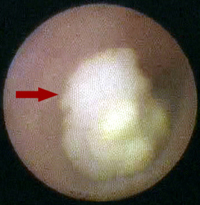

 |  |
PERFORMING SALIVARY ENDOSCOPY: Minimally Invasive Removal of Salivary Gland Stones

![]() Dr. Mark F. Marzouk is a specialist in the relatively new minimally invasive procedure of salivary endoscopy. This procedure allows for the removal of salivary gland stones and relief of salivary duct stenosis (narrowing). It is performed on an outpatient basis, and patients generally are able to go home the same day. In most cases, the salivary gland does not have to be removed. Sparing the salivary gland is one of the major benefits associated with this procedure.
Dr. Mark F. Marzouk is a specialist in the relatively new minimally invasive procedure of salivary endoscopy. This procedure allows for the removal of salivary gland stones and relief of salivary duct stenosis (narrowing). It is performed on an outpatient basis, and patients generally are able to go home the same day. In most cases, the salivary gland does not have to be removed. Sparing the salivary gland is one of the major benefits associated with this procedure.
Sialolithiasis, or stones in the salivary duct, is the most common disease of the salivary gland. It affects approximately 12 in 1,000 adults. Symptoms of sialolithiasis include pain, intermittent swelling of the gland, and possibly severe infection.
Salivary endoscopy is a minimally invasive technique that allows for salivary gland surgery in a safe and effective way, and is done on an outpatient basis.
The current standard in most institutions for treating salivary duct stones has been surgical removal of the gland that entails an incision in the neck and an overnight stay in the hospital.
Salivary endoscopy spares the gland without risk to adjacent vital structures such as the tongue and facial nerves, and patients can go home the same day.
The success rate of salivary endoscopy is over 90%, as reported in the current literature, with less than 5% recurrence. Recovery time is much faster than with an open technique, and patients may return to a normal diet the same day.
Stony Brook University Medical Center is the only institution in both Nassau and Suffolk counties currently providing this truly state-of-the-art service to patients.
Dr. Marzouk's practice is focused on the treatment of cancer of the head and neck and management of diseases of the salivary glands. He has special interest and training in the newest techniques in minimally invasive and endoscopic treatment of head and neck disease.
Salivary endoscopy with steroid injection is now giving new hope to patients suffering with post-radiation sialadenitis. These patients suffer from chronic inflammation of the salivary glands secondary to radiation exposure with symptoms of pain and dry mouth.
Until now, these patients had few to no options for treatment. However, the new endoscopic approach offers safe access to the gland with local infiltration of steroids, thus decreasing inflammation to the gland. Up to 75% of patients have shown improvement of their symptoms with this intervention.
THE PROCEDURE

![]() Salivary endoscopy involves placement of a 1.1 mm endoscope (about one-sixteenth of an inch thick) into the salivary duct, and can be done with patients under local anesthesia in selected cases. The endoscope is a thin, tube-like instrument with a video camera plus light and channels to enable passage of surgical instruments.
Salivary endoscopy involves placement of a 1.1 mm endoscope (about one-sixteenth of an inch thick) into the salivary duct, and can be done with patients under local anesthesia in selected cases. The endoscope is a thin, tube-like instrument with a video camera plus light and channels to enable passage of surgical instruments.
First, the papilla of the duct is dilated transorally with probes of increasing size. A small endoscope is then introduced into the duct so the anatomy can be visualized as the duct is being irrigated. This provides 360-degree visualization of the lumen from papilla to the actual gland.
Salivary endoscopy — first done in 1990 — is made possible by the development of miniaturized imaging tools that can fit inside tiny parts of the body.
Any stenosis can be dilated using a balloon dilator, biopsies can be taken, and stones up to 5 mm in size (about one quarter of an inch) can be harvested using a wire basket.
Steroids can also be injected in cases of radiation-induced sialadenitis. In cases of larger stones, a combined approach can be utilized in which endoscopic manipulation of the stone is done with transoral sialodochoplasty, or incision on the duct, to remove the stone with marsupialization. This provides markedly less risk of morbidity compared to an open approach.
Pioneered by Francis Marchal, MD, PhD, at the University of Geneva, Switzerland, the salivary endoscopy procedure has had tremendous success, and is truly one of the most fascinating innovations introduced in the recent years in the field of otolaryngology-head and neck surgery.
